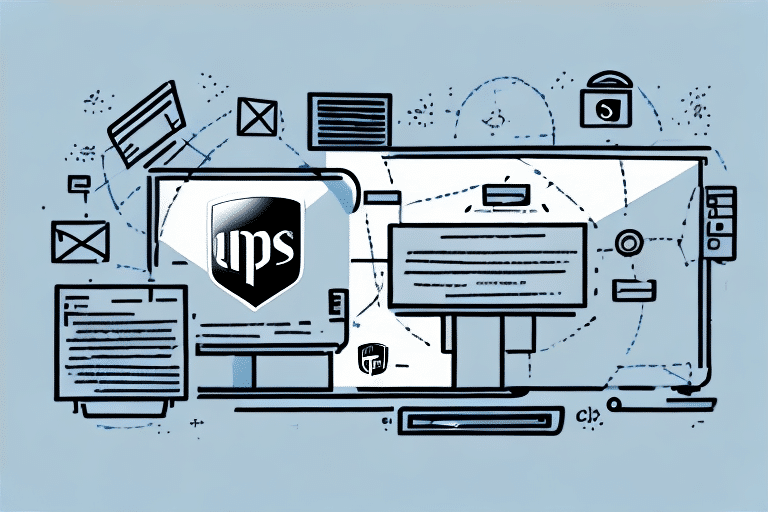Automating Your Shipping Process with UPS WorldShip's Automatic Batch Import
For businesses that rely heavily on shipping to fulfill customer orders, managing the manual process can often be time-consuming and error-prone. To streamline the shipping process, UPS WorldShip offers a variety of features that help businesses reduce errors, save time, and lower shipping costs. One such feature is the automatic batch import. In this article, we'll explore what UPS WorldShip is, how it can benefit your business through automating your shipping process, and how to implement and optimize the automatic batch import feature to elevate your shipping operations.
What is UPS WorldShip and Its Business Benefits?
UPS WorldShip is a desktop shipping application designed to help businesses manage their shipping processes efficiently. It offers a range of features, including address validation, package tracking, and shipping rate calculations, among others. By integrating with UPS's online services, WorldShip enables businesses to consolidate their shipping activities within a single platform.
Implementing UPS WorldShip can benefit your company in several ways:
- Reduced Errors: Centralizing the shipping process minimizes the risk of human error, leading to more accurate shipments.
- Time Savings: Automation streamlines tasks such as label creation and data entry, allowing employees to focus on other priorities.
- Cost Efficiency: WorldShip provides tools to compare shipping rates and choose the most cost-effective carrier options.
- Customization: Businesses can customize shipping labels and documents to include branding elements, enhancing brand recognition.
- Data Insights: Detailed reporting features allow businesses to analyze shipping data and make informed decisions to optimize their logistics.
According to a UPS Business Solutions report, businesses that utilize shipping management software like WorldShip can increase shipping efficiency by up to 30%, significantly impacting overall operational productivity.
Advantages of Automating Your Shipping Process
Automating the shipping process offers numerous benefits that enhance efficiency, reduce errors, and improve customer satisfaction. Key advantages include:
- Increased Efficiency: Automation speeds up the entire shipping workflow from order processing to delivery.
- Error Reduction: Automated data entry and label creation reduce the likelihood of shipping errors.
- Cost Savings: By minimizing manual tasks, businesses can lower labor costs and take advantage of optimized shipping rates.
- Improved Customer Experience: Faster and more accurate shipping leads to timely deliveries, enhancing customer satisfaction.
- Real-time Tracking: Automated systems provide real-time visibility into shipment statuses, allowing businesses and customers to track packages accurately.
According to a 2023 McKinsey report, automation in logistics can improve operational efficiency by 20-30%, resulting in significant cost reductions and faster delivery times.
Understanding the Batch Import Feature in UPS WorldShip
The batch import feature in UPS WorldShip allows businesses to import multiple orders into the system simultaneously from a file, such as CSV or Excel. This feature streamlines the order processing and shipping workflow by eliminating the need for manual data entry.
Key aspects of the batch import feature include:
- Template Creation: Users can create templates with the necessary data fields to match their order information.
- Data Accuracy: By importing data in bulk, the likelihood of data entry errors is significantly reduced.
- Time Efficiency: Processing large volumes of orders becomes much faster compared to manual input.
Research by Supply Chain Digital indicates that batch processing in shipping can decrease order processing times by up to 40%, leading to faster fulfillment and delivery.
Setting Up Automatic Batch Import in UPS WorldShip: A Step-by-Step Guide
Setting up the automatic batch import feature in UPS WorldShip involves several steps to ensure seamless integration and operation:
- Access the Import/Export Menu: Open UPS WorldShip and navigate to the Import/Export section from the main menu.
- Select "Import Transactions": Choose the type of transaction you wish to import, such as "Shipment" or "Address Book".
- Choose Import Type: Select "Batch File Import" to import multiple transactions at once.
- Create a Template: Define the data fields required for your orders, ensuring they match the format of your import file.
- Schedule Automatic Imports: Set up automated imports by scheduling them to occur at specific intervals (daily, weekly, etc.) to maintain continuity in your shipping operations.
Ensure that your import files adhere to the required format (e.g., CSV) and that all necessary data fields are accurately populated to prevent import errors. For detailed instructions, refer to the official UPS WorldShip documentation.
Optimizing Your Shipping Process with UPS WorldShip
To fully leverage UPS WorldShip for optimizing your shipping process, consider the following strategies:
- Utilize Advanced Features: Take advantage of features such as address validation, automated label creation, and rate comparison tools to enhance your shipping workflow.
- Customize Shipping Labels: Incorporate your company logo and branding elements into shipping labels and documents to promote brand recognition.
- Monitor Shipping Metrics: Use the reporting tools in WorldShip to analyze shipping volumes, carrier usage, and costs to identify areas for improvement.
- Implement Real-time Tracking: Provide customers with real-time tracking information to improve transparency and satisfaction.
According to a Inbound Logistics study, businesses that actively optimize their shipping processes through automation can reduce shipping costs by up to 15% while improving delivery times.
Integrations and Enhancements for Seamless Shipping Management
Integrating UPS WorldShip with your existing eCommerce platform can further enhance shipping management and order fulfillment processes. Key integration benefits include:
- Automated Order Import: Automatically import orders from your eCommerce platform into WorldShip, reducing manual tasks.
- Automated Label Printing: Streamline label creation by automating the printing process directly from your order data.
- Enhanced Reporting: Combine data from your eCommerce platform and WorldShip to generate comprehensive shipping reports.
- Real-time Updates: Ensure that order statuses and tracking information are updated in real-time across all systems.
Platforms like Shopify and WooCommerce offer built-in integration options with UPS WorldShip, facilitating seamless shipping management.
Cost Savings and ROI with UPS WorldShip's Automatic Batch Import
Implementing UPS WorldShip's automatic batch import feature can lead to significant cost savings and a strong return on investment (ROI) for businesses:
- Labor Cost Reduction: Automating data entry minimizes the need for manual labor, allowing staff to focus on higher-value tasks.
- Error Minimization: Reducing shipping errors decreases costs associated with returns, reshipping, and customer service issues.
- Operational Efficiency: Faster processing times lead to quicker order fulfillment and reduced delivery times, enhancing customer satisfaction.
- Scalability: Automatic batch import supports business growth by efficiently handling increasing order volumes without proportional increases in labor costs.
According to a Gartner analysis, companies investing in shipping automation can achieve an ROI of over 200% within the first two years, primarily through labor savings and increased order accuracy.
Comparison of UPS WorldShip with Other Shipping Automation Tools
While UPS WorldShip is a robust solution for shipping automation, it's essential to consider other tools available in the market to determine the best fit for your business needs. Notable alternatives include:
- ShipStation: Known for its user-friendly interface and extensive integrations with various eCommerce platforms. It offers features such as automation rules, branded labels, and comprehensive reporting.
- Shippo: A flexible shipping API that allows businesses to integrate shipping calculations, label printing, and tracking into their systems. It's particularly favored by startups and developers for its scalability.
- EasyShip: Provides an intuitive shipping platform with global label generation, customs documentation, and multi-carrier support.
When comparing these tools, consider factors such as pricing, ease of use, integration capabilities, and specific feature sets. According to Capterra's comparison, UPS WorldShip stands out for its comprehensive feature set tailored for businesses with high shipping volumes, while alternatives like ShipStation and Shippo offer more flexible pricing models and integrations for small to medium-sized businesses.
Best Practices for Managing International Shipping with UPS WorldShip
Managing international shipments can be complex due to varying customs regulations, tariffs, and documentation requirements. Here are best practices for using UPS WorldShip to handle international shipping effectively:
- Accurate Customs Documentation: Ensure that all required customs forms are correctly filled out to prevent delays and additional fees.
- Correct Address Formatting: Verify that recipient addresses comply with international standards to facilitate smooth delivery.
- Rate Verification: Confirm shipping rates and fees for international destinations to maintain accurate cost calculations.
- Tracking and Visibility: Utilize WorldShip's tracking features to monitor international shipments in real-time, providing both your business and customers with up-to-date information.
- Compliance with Regulations: Stay informed about international shipping regulations and ensure that your shipments comply with all legal requirements.
According to the World Bank, effective management of international shipping processes can reduce delivery times by 25% and lower costs by 15%, enhancing overall business competitiveness in global markets.
Customer Experience Improvements through Streamlined Shipping with UPS WorldShip
Enhancing the customer experience is crucial for retaining customers and fostering loyalty. Streamlining your shipping process with UPS WorldShip's automatic batch import can significantly contribute to customer satisfaction:
- Faster Deliveries: Automated batch processing accelerates order fulfillment, ensuring that customers receive their orders promptly.
- Accurate Shipping Information: Automation reduces errors in shipping details, leading to fewer lost or misrouted packages.
- Real-time Tracking: Providing customers with accurate tracking information enhances transparency and trust.
- Professional Presentation: Customized shipping labels and documents reflect your brand's professionalism, creating a positive impression.
- Responsive Support: Fewer shipping errors result in less need for customer service interventions, allowing support teams to focus on higher-value interactions.
Studies from the Bain & Company highlight that improving customer experience through efficient shipping processes can increase customer retention rates by up to 25%, directly impacting revenue growth.
Future Developments and Updates in Shipping Automation: What to Expect from UPS WorldShip
The shipping automation landscape is continuously evolving, and UPS WorldShip is poised to introduce further enhancements to meet the growing needs of businesses:
- Advanced Integration Capabilities: Enhanced integrations with emerging eCommerce platforms and business systems to provide more seamless data flows.
- Artificial Intelligence and Machine Learning: Implementation of AI-driven features for predictive analytics, route optimization, and automated decision-making.
- User Interface Improvements: Ongoing refinements to the user interface to increase usability and efficiency for administrators.
- Expanded Automation Features: Additional automated functionalities such as automated returns processing and dynamic shipping options based on customer preferences.
- Enhanced Security Measures: Implementation of advanced security protocols to protect shipping data and ensure compliance with data protection regulations.
By staying abreast of these developments, businesses can ensure that their shipping processes remain efficient, cost-effective, and aligned with the latest technological advancements in logistics automation.






















